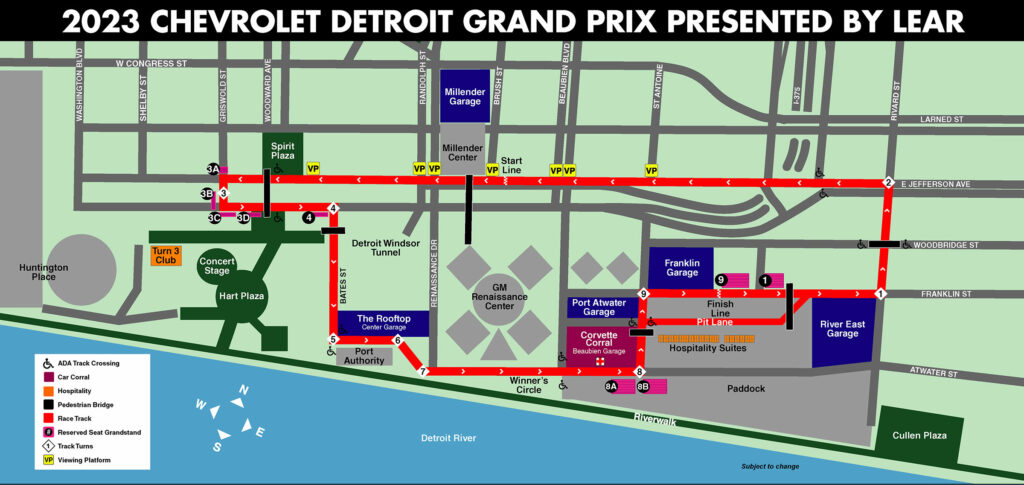“Maybe, just maybe, it would be appropriate and very fitting that one of Roger’s drivers would win on the last possible time… the Chevrolet Detroit Grand Prix, the last one on Belle Isle is won by Will Power,” exclaimed Leigh Diffey. That was the call for the end of the 2022 Detroit Grand Prix.
Power captured the 100th win for Chevrolet since they rejoined the series in 2012. It was fittingly on Belle Isle, located in the international waters of the Detroit River, with the General Motors World Headquarters, the Renaissance Center, in the background. Power’s win, like many previous on Belle Isle, was celebrated with a joyous jump into the Scott Fountain. Power will likely be the last driver in the foreseeable future to do so. With IndyCar’s last laps around the Belle Isle circuit, the Detroit Grand Prix is moving off Belle Isle back to the city streets this year. Although, in an interview with WDIV, the local news channel, when asked what winners will get to do instead of jumping in the fountain, he jokingly replied, “I was gonna jump in the river. They can have divers there, about a mile downstream… I think they’re gonna have something pretty cool there. It’ll look good.”
Detroit, commonly known as “The Motor City,” is the automotive capital of the country, if not the world. It has hosted an auto race intermittently since the late 80s. Downtown has played host to many different racing series. It held Formula One races from 1982-1988, and both the Indy Racing League (IRL) and Championship Auto Racing Teams (CART) raced throughout the 1990s. IRL and CART were the entities that came together to create what is today known as IndyCar, which has yet to race on the streets of Detroit, but that is about to change on June 2-4, 2023.
There were many factors that contributed to making that change. An activist group, Belle Isle Concern, was worried about the negative effect that the race was having on the amount of people visiting the park, and its environmental impact. There was also the barrier of getting race fans to the track, having to bus them down Jefferson across the bridge to the island, and then back to the city after each day for the three-day race weekend. It was ultimately decided that after the 2022 race, IndyCar would move back to the city and leave the island.
A November 2021 panel featured many influential members from both Detroit’s governing bodies and IndyCar figures. Bud Denker, President of Penske Corporation and Chairman of the Detroit Grand Prix, discussed some of the reasoning for bringing the race off Belle Isle; “Belle Isle has limitations, physical, barrial, as far as geographic limitations.” Moving to Detroit would presumably come with its own challenges, but Denker, along with other Detroit officials, IndyCar and otherwise, agreed it was time for a change.
A significant part of this new track layout stems from the need to keep the city moving during race weekend. On Belle Isle, roads could be shut down and not cause a disruption to the normal city traffic. With Jefferson, one of busiest surface roads in Detroit being used for racing, it would cause a major disruption to travel if it was closed completely. Denker had a solution for this: “I’m going to allow cars to come into our circuit, drive 12 feet away from a car going 190 miles an hour next to you as you drive into the tunnel and out of the tunnel,” said Denker, in an interview with IndyCar. The tunnel he referenced is the Detroit Windsor Tunnel, which moves thousands of cars internationally every day. The tradeoff in track design was the efficiency it could provide for the city in comparison to the racing product itself.
The track itself will no doubt be something to behold. Generally rectangular, it features nearly all hard 90 degree turns, minus a hairpin turn on Jefferson, and a brief jog behind the Renaissance Center for turns 6 and 7. In the press conference, IndyCar champion Josef Newgarden, discussed how he was looking forward to the new layout. “Truly, I was very impressed. I think we’ve actually, in Detroit, got a leg up on Nashville… From a driving standpoint I think this track is gonna race really well. The highlight for me was Jefferson Street,” Newgarden said, “it excited me.”
Especially unique, this new layout will feature the first time that IndyCar has ever utilized a two-way pit lane. After cars make a hard right turn into the pits, they will then have to box, either to the left or right. This decision was most likely made due to limited space in such an urban center. This then brings up the question of what if the whole field pits for an instance, such as a yellow or red flag? It could be a cause of even more issues, but the decision was obviously made while taking this into consideration, and its efficiency will be determined after the first on track session.

With the track layout and pit arrangement, it seems reminiscent of the last two Music City Grand Prix in Nashville. Both of those races were riddled with yellow and red flags, and for that reason are viewed as unpredictable and chaotic. It is needless to say that much consideration has been taken in the creation of the new Detroit track, and its fans and Detroiters alike are hoping for a successful weekend.
Crews have been working on repairing and repaving roads and parking lots to get them into racing condition. These projects include Atwater Street, near the river, as they convert parking lots that lie on it into the paddock and pit lane. Although this is good for the racing surface, it is even better for the city, which has been notoriously known for poor road quality.
Beyond improving the roads, another goal of moving the race is to create access for hundreds, if not thousands of spectators – for free. It will allow race fans and Detroiters alike to view large regions of the track at no cost. This could be an effective strategy for motorsport as a whole to remove the cost barrier for casual race fans or people with any interest in motorsport who may otherwise not, if they had to purchase a ticket.
Free Prix Day on Friday has always been one of the most cherished aspects of the Belle Isle race, eliminating economic barriers for fans. On Belle Isle, this included access to the paddock. Spectators could stand no more than 20 feet from teams working on their cars. This access is nearly unparalleled, and is set to continue in the city. Access to the paddock is also included on Saturday and Sunday with a purchased ticket. With so much of the race weekend being free, it will hopefully be a large pull for locals to come experience the event while shopping and eating locally at Detroit businesses.
Arguably, the main goal for moving back to the city was the benefit it would bring to local business. Denker said, in the same press conference, ”The engagement with business, the engagement with our community especially is what excites me the most.”
Detroit Mayor, Mike Duggan, then went on to reflect on races he had been to in the late 80s. “Everybody was packed in windows and cheering it on; you had crowds on the street, it supported the Detroit restaurants and the shops, it was accessible to everybody, and there was something about the sound echoing off those buildings that was really powerful,” he said. Brenda Jones, Detroit City Council President, then went on to discuss her excitement for IndyCars return. “Not only am I excited. I can tell you the community is excited… The community will have an opportunity to watch it themselves. To experience it. One of the things that is important to me is to get the community involved in what’s happening in the city of Detroit.”
Detroit has steadily been on the rise since it filed for bankruptcy in 2013. Hosting the race downtown, now 10 years later, will be a beneficial experience to demonstrate to both the IndyCar community, and national audience that Detroit is still the Motor City, something that people will get to experience in less than four months.
“Coming back to the streets of the city is going to help the businesses in the City of Detroit. All so often we forget about our businesses, our small businesses. Some of the businesses will be able to come from their districts to set up booths, right downtown so that people will know what’s in their district,” said Jones. “We can showcase not just downtown Detroit but the entire city of Detroit can be showcased just by moving the Grand Prix.” The businesses from other districts of Detroit – not just the two downtown – will be able to sell their products.
IndyCar is not the first series to adopt a new street course. The model of bringing auto races to city streets seems to be gaining popularity. In Formula One, they have doubled down on a plan for a race in Las Vegas, where the cars will be accelerating down the Vegas Strip. They are succeeding by turning it into more than just a race. In Vegas, sure it is a race weekend, but it is also an experience, a spectacle.
IndyCar must keep up with that model, albeit very extravagant, if it intends to compete in any way in the global racing market. They can start with Detroit. There is no place to start that is more driven, that cares more about cars, than here, in the Motor City.
